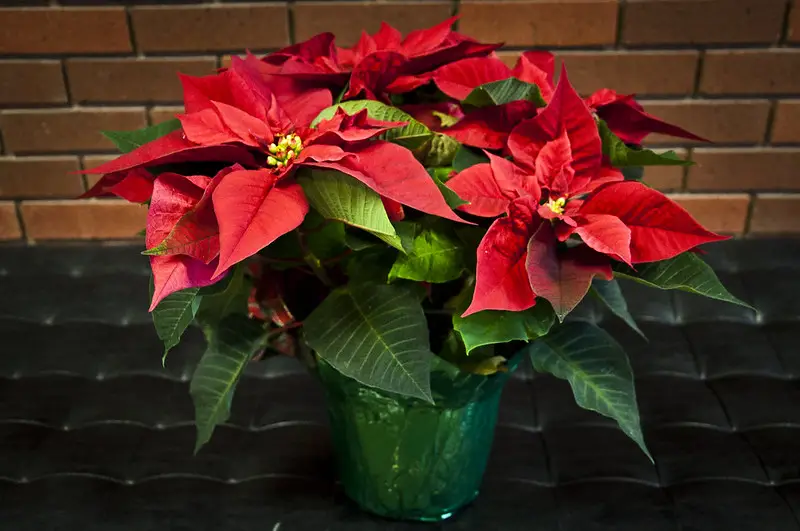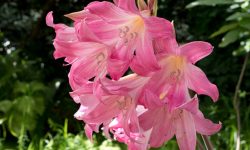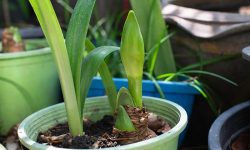Poinsettias are iconic holiday plants, admired for their bright red, pink, or white bracts that bring festive cheer during the winter season. While many people treat them as disposable decorations, poinsettias are perennial plants that can bloom year after year with the right care. Encouraging a poinsettia to bloom again requires understanding its natural growth cycle, mimicking its native environment, and providing the proper care throughout the year.
This tropical plant, native to Mexico, thrives in warm climates and relies on specific light and temperature changes to trigger its colorful bracts. Learning how to manage these conditions effectively will allow you to enjoy vibrant poinsettia blooms not just for one holiday season, but for many seasons to come.
Understanding the Blooming Cycle of Poinsettias

Poinsettias do not produce true flowers in the way many people think. The bright, colorful parts often mistaken for petals are actually modified leaves called bracts, while the real flowers are the small yellow buds in the center. These bracts change color in response to a process called photoperiodism, which is the plant’s natural reaction to shorter daylight hours and longer nights during winter.
The blooming cycle begins when the plant enters a rest period after the holidays. During this phase, the plant sheds some leaves and conserves energy. New growth starts in spring and continues through summer, but the characteristic colorful bracts only appear when the plant experiences extended periods of darkness in the fall.
Knowing this cycle is crucial for anyone who wants their poinsettia to bloom again. You must provide the correct care during each phase of the year to ensure the plant remains healthy and ready to produce its festive colors when the season arrives.
Giving Your Poinsettia the Right Light for Blooming
Light is one of the most important factors in making a poinsettia bloom again. During its growth phase in spring and summer, the plant needs plenty of bright, indirect sunlight to maintain healthy green foliage and build enough energy for the blooming season. Placing the plant near an east- or south-facing window where it receives morning sunlight works best, as direct afternoon sun can scorch the leaves.
As autumn approaches, the light schedule must change to trigger blooming. Poinsettias are short-day plants, which means they need long periods of uninterrupted darkness to initiate the color change in their bracts. Starting in early fall, the plant should receive about 14 hours of complete darkness every night for six to eight weeks. This darkness can be achieved by placing the plant in a dark room, inside a closet, or covering it with a box or opaque cloth from evening until morning. Even a brief exposure to artificial light during the night can disrupt this process and delay blooming.
Once the bracts begin to show color, the plant can return to its normal bright location. Consistent light during the day and complete darkness at night are the keys to producing bold, vibrant bracts.
Maintaining the Ideal Temperature for Blooming
Temperature control is just as important as light when encouraging a poinsettia to bloom again. During its active growing season, the plant thrives in temperatures between 65 to 75°F (18 to 24°C). Cooler nights around 60°F (15°C) are beneficial, as they help strengthen the plant and prepare it for blooming.
When the bloom-inducing darkness treatment begins in the fall, maintaining consistent temperatures becomes even more important. Excessive heat or cold can stress the plant, causing leaves to drop and reducing the chances of colorful bracts developing. Avoid placing the poinsettia near heaters, air conditioners, or drafty windows, as sudden temperature fluctuations can disrupt its blooming cycle.
Once the bracts start changing color, slightly cooler temperatures between 60 to 70°F (15 to 21°C) will help preserve the vibrancy of the bracts and extend the blooming period through the holiday season.
Watering Techniques for Healthy and Vibrant Bracts
Proper watering plays a crucial role in keeping a poinsettia healthy enough to bloom again. During the growing months, the plant prefers evenly moist soil but cannot tolerate standing water. Overwatering leads to root rot, while allowing the soil to dry out completely causes leaf drop and weak growth. Checking the top layer of soil regularly and watering when it feels slightly dry is the best approach.
As the plant enters its blooming phase, maintaining consistent soil moisture becomes even more important. The bracts need adequate hydration to develop fully and maintain their vibrant color. Watering deeply and allowing excess water to drain from the pot ensures the roots receive enough moisture without becoming waterlogged. Using room-temperature water is recommended, as cold water can shock the roots and stress the plant.
Reducing watering slightly after the blooming season allows the plant to enter its natural rest period. This controlled watering schedule supports the plant’s natural growth cycle and encourages strong, healthy blooming the following year.
Feeding Your Poinsettia for Long-Lasting Blooms
Fertilizing regularly during the growing season helps the plant store enough nutrients to produce its bright bracts later in the year. A balanced, water-soluble fertilizer with equal parts nitrogen, phosphorus, and potassium works well during spring and summer to support foliage growth and overall plant health.
As fall approaches and the darkness treatment begins, switching to a fertilizer with slightly higher phosphorus content helps encourage strong bract development. Fertilizing every two to four weeks during this pre-blooming period ensures the plant has enough nutrients to produce rich, vibrant colors.
Once the bracts reach their full color, fertilizing can be reduced or temporarily stopped to allow the plant to focus on maintaining the blooms rather than producing new growth. After the holiday season ends, feeding should resume to help the plant recover and prepare for the next blooming cycle.
Pruning at the Right Time to Encourage Re-Blooming
Pruning is another essential step in making a poinsettia bloom again. After the holiday season, when the bracts start to fade, cutting the plant back encourages new growth and prepares it for the next cycle. Pruning should be done in late winter or early spring, trimming the stems back to about six inches above the soil.
This pruning stimulates the development of new shoots, which will form the branches needed to support future bracts. Removing dead or weak stems also improves air circulation and reduces the risk of disease, keeping the plant strong and healthy.
Light pruning throughout the summer can help maintain a compact, bushy shape, which not only looks more attractive but also supports more even bract development when the plant enters its blooming phase.
Managing Humidity to Keep Bracts Fresh and Colorful
Poinsettias are native to tropical climates, so they thrive in moderately humid environments. Indoor heating during winter can make the air very dry, which causes bracts and leaves to wilt or drop prematurely. Increasing humidity around the plant helps keep the bracts fresh and vibrant for a longer time.
Placing a humidity tray filled with water and pebbles beneath the pot is an easy way to raise moisture levels around the plant. Grouping poinsettias with other houseplants or using a humidifier can also help create a more suitable environment. Misting the leaves lightly can provide temporary relief, but care should be taken to avoid spraying directly on the colorful bracts, as excess moisture can cause spotting or fungal issues.
Maintaining steady humidity throughout the blooming season ensures the plant retains its festive appearance and extends the life of its colorful bracts.
Protecting Poinsettias from Stress for Longer Blooming Periods
Even with proper care, stress can cause a poinsettia to lose its bracts early. Protecting the plant from sudden environmental changes is crucial for keeping it blooming and colorful throughout the holiday season. Avoid moving the plant frequently, as changes in light and temperature can cause leaf and bract drop.
Keeping the poinsettia away from drafty windows, heat vents, and direct blasts of cold air will also help maintain stable conditions. Handling the plant gently when watering or adjusting its position is important, as bumping or shaking the branches can cause the bracts to fall prematurely.
Consistency is the key to success. A stable environment with the right light, temperature, and humidity levels will keep the plant stress-free, ensuring its bright colors last for weeks.
Caring for Poinsettias After Blooming to Prepare for Next Year
Once the holiday season is over and the bracts begin to fade, the plant naturally enters a rest period. This post-bloom care is essential for encouraging future blooms. Gradually reduce watering to allow the plant to rest, but do not let the soil dry out completely.
As spring approaches, begin regular watering and feeding to encourage new growth. Moving the plant outdoors to a shaded location during the warmer months can help strengthen it, but it should be acclimated slowly to avoid sunburn. By late summer, bringing the poinsettia back indoors and starting the darkness treatment will prepare it for another round of holiday blooms.
With proper care throughout the year, poinsettias can continue to bloom beautifully every holiday season, becoming a cherished part of festive traditions.
FAQs about How to Make a Poinsettia Bloom Again
Why Is My Poinsettia Not Blooming Again?
Poinsettias may fail to bloom due to insufficient darkness during fall, inconsistent watering, or exposure to extreme temperatures. Providing about 14 hours of uninterrupted darkness nightly for 6-8 weeks in early fall is essential to trigger blooming.
How Long Does It Take for a Poinsettia to Bloom Again?
After starting the darkness treatment, it usually takes 6 to 8 weeks for the bracts to change color. Once color appears, blooms can last for several weeks with proper care.
Can I Keep My Poinsettia Healthy After Blooming?
Yes, with proper pruning, watering, and feeding, poinsettias can remain healthy year-round and bloom again next season. Post-bloom care includes cutting back stems and providing bright, indirect light during growth periods.
What Is the Best Temperature for Poinsettia Blooming?
Ideal temperatures range from 65 to 75°F (18 to 24°C) during the day and around 60°F (15°C) at night. Avoid drafts and sudden temperature changes to prevent stress and leaf drop.
How Should I Water My Poinsettia for Best Results?
Water poinsettias when the top inch of soil feels dry, ensuring thorough watering without letting the plant sit in water. Consistent moisture supports healthy growth and vibrant bracts.
Final Thoughts on Making a Poinsettia Bloom Again
Encouraging a poinsettia to bloom again is not as difficult as many believe. By understanding its natural growth cycle and providing consistent care, you can enjoy its vibrant bracts year after year. Proper light exposure, temperature control, regular feeding, and timely pruning all work together to ensure healthy growth and spectacular blooms.
Patience and consistency are the most important factors in success. Once you establish the right routine, your poinsettia will reward you with its stunning festive display every winter, making it a beautiful and long-lasting symbol of the holiday season.






